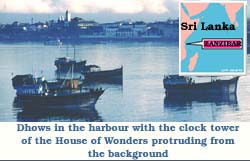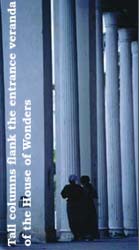 |
 3rd May 1998 |
Front Page| |
Zanzibar: land of legend and fable
It was one of the more interesting propositions put to us by Ali, the inevitable urchin who latched onto us as we walked out of the port on arrival at Zanzibar. Ali was referring to nothing less than the building constructed in 1881 as a ceremonial palace for the sultan.
Ali had not earned the right to guide visitors because of his smile alone. Stone Town was his. He scuttled off, found the appropriate caretaker to bribe, and beckoned us to follow him through a small door set in the great building's side wall. We were in the House of Wonders. The sultan's palace, known as Beit Al Ajaib, was dubbed the House of Wonders when, in 1906, an American company approached the Sultan with a scheme to build a railway. The enterprising Americans offered to furnish the Palace with electric light and fans if the Sultan granted them the railway concession. He agreed, light was installed; and the Palace became the most wondrous building in Zanzibar. There is no trace of the railway now. It was known as the Bububu Light Railway. Three feet gauge, the open-sided carriages were hauled by American Porter 0-4-4Ts steam locomotives with chimney cinder catchers. Railcars were also pulled by mules. It was taken over by the government in 1911 and closed because of competition from motor traffic in 1927. To our surprise the first objects we saw as we edged with curiosity into the deserted palace, were motor cars. The inner courtyard had become the parking place for the limousines of former regimes. An impressive Ford Zephyr belonged to the first president; it was flanked by a Wolseley, an Austin 40 and a Simca. An electric lift, with a notice in Swahili tacked on to its grille announcing the obvious, that it was broken, rested at the bottom of the shaft from where it used to glide to upper floors. We climbed the grand wooden staircase instead, inspecting the emptiness of the vast, high ceilinged rooms. On the top floor balcony we stood and gazed out at the dhows and cruise ships anchored in the harbour. Zanzibar retains the essence of fable and legend that lures visitors there. The country's heart, Stone Town, is a warren of alleys running between tall buildings, some with exterior balconies, others built with balconies looking in on themselves over interior courtyards. In Sri Lanka, the equivalent is Galle Fort, also an ancient port of Arab traders but with streets too wide to foster the mysterious atmosphere that lingers in Stone Town. In the past, such visitors as the explorer David Livingstone, whose presence in Stone Town is commemorated by a rusty plaque on the side of the former British consulate building, found the town ponged a bit. Livingstone wrote rudely that the island should be called "stinkibar rather than Zanzibar." Visitors today can also get wind of Zanzibar from afar, but now the odour of slaves herded into pens for shipment has been replaced by the heady bouquet of cloves. We saw,and smelt, green cloves being transferred from trucks into waterfront warehouses to await export. Gradually, as we walked with Ali outside the port, the aroma was overwhelmed by the smell of fish, landed beside the harbour where ancient dhows from far- off shores bobbed at anchor.
We wish we could have stayed, for Stone Town is a living reminder of a rich, cultural heritage where Arab, Indian, Persian and European influences blend with local African tradition: a rare and exciting port of call. Travel Notes: Zanzibar is no longer isolated. There are flights from Colombo, via Muscat with Gulf Air, and via Dubai by Emirates to Dar Es Salaam from where the ferry goes to the port at Stone Town. |
||
 |
More Plus * C'wealth Writers' Prize: No takers? * Removing the stumbling block
Front Page| News/Comment| Editorial/Opinion| Business| Sports | Mirror Magazine |
|
 |
Please send your comments and suggestions on this web site to |
|
 STONE
TOWN, ZANZIBAR: "Why don't you buy the House of Wonders and turn it
into a hotel?"
STONE
TOWN, ZANZIBAR: "Why don't you buy the House of Wonders and turn it
into a hotel?" Its
wonderful facade of tall columns, topped with a wooden clock tower, is
visible from the harbour. It looked neglected and forlorn as we stood in
front of its battened down doors and windows, gazing up at the broad, empty
balconies. We wondered what was inside this landmark building.
Its
wonderful facade of tall columns, topped with a wooden clock tower, is
visible from the harbour. It looked neglected and forlorn as we stood in
front of its battened down doors and windows, gazing up at the broad, empty
balconies. We wondered what was inside this landmark building.  But
for most visitors, it is the fortress- like inner city of Stone Town that
is the reason for journeying to Zanzibar. Part of Tanzania since 1964,
the island lies about 50 miles from Dar Es Salaam, six degrees south of
the Equator. There is a population of some 800,000 with 100,000 of them
cloistered behind the thick stone walls in the former palaces and grand
mansions that make up Stone Town.
But
for most visitors, it is the fortress- like inner city of Stone Town that
is the reason for journeying to Zanzibar. Part of Tanzania since 1964,
the island lies about 50 miles from Dar Es Salaam, six degrees south of
the Equator. There is a population of some 800,000 with 100,000 of them
cloistered behind the thick stone walls in the former palaces and grand
mansions that make up Stone Town.